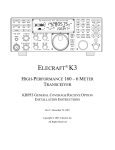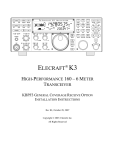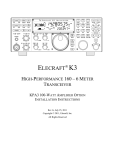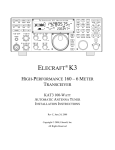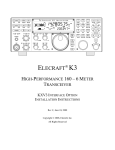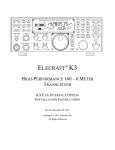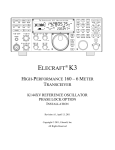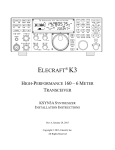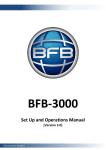Download ELECRAFT KRX3 Specifications
Transcript
ELECRAFT® K3 HIGH-PERFORMANCE 160 – 6 METER TRANSCEIVER KBPF3 GENERAL COVERAGE RECEIVE OPTION INSTALLATION INSTRUCTIONS Rev D, June 24, 2008 Copyright © 2008, Elecraft, Inc. All Rights Reserved Contents Introduction............................................................................................................................................... 3 Customer Service and Support............................................................................................................................ 3 Technical Assistance ....................................................................................................................................... 3 Repair / Alignment Service ............................................................................................................................. 3 Preventing Electrostatic Discharge Damage ............................................................................................ 4 How ESD Damage Occurs.................................................................................................................................. 4 Preventing ESD Damage..................................................................................................................................... 4 Preparing for Installation .......................................................................................................................... 5 Tools Required .................................................................................................................................................... 5 Parts Included...................................................................................................................................................... 6 Installation Procedure ............................................................................................................................... 6 Removing the Top Cover .................................................................................................................................... 6 Removing the KRX3 Subreceiver Module ......................................................................................................... 7 Installing the KBPF3 in the KRX3 Subreceiver ................................................................................................. 8 Installing KBPF3 Standoffs on KRX3 Board ................................................................................................. 9 Installing the KBPF3 on the KRX3 Board.................................................................................................... 10 Installing the KBPF3 in the K3 Main Receiver ................................................................................................ 11 Installing the Standoffs on the K3 RF Board ................................................................................................ 11 Installing the KBPF3 Board on the K3 RF Board......................................................................................... 13 Reassembly ....................................................................................................................................................... 14 Enable the KBPF3 Module ............................................................................................................................... 15 2 Introduction This manual covers the installation of the KBPF3 General Coverage Receive option in your K3 transceiver. The KBPF3 provides the proper input filters to optimize receiver sensitivity outside of the Ham bands over the tuning range of 500 KHz to 30 MHz and from 48 MHz through 54 MHz. Either the main K3 receiver or the optional KRX3 subreceiver may be equipped with the KBPF3. The KBPF3 consists of a single circuit board supported by two threaded standoffs. It plugs into the K3 RF board that covers the bottom of the K3 chassis enclosure, or the KRX3 Subreceiver board inside the shielded enclosure. Many K3s are already equipped with the necessary standoffs in both the KRX3 subreceiver and the main receiver. For those without the necessary standoffs pre-installed, a pair of standoffs and all the necessary hardware is included in this kit, along with full instructions for installing them. In any case, only a few simple hand tools are needed and the installation does not involve any soldering. The tools required are listed on page 5. Customer Service and Support Technical Assistance You can send e-mail to [email protected] and we will respond quickly - typically the same day Monday through Friday. Telephone assistance is available from 9 A.M. to 5 P.M. Pacific time (weekdays only) at 831662-8345. Please use e-mail rather than calling when possible since this gives us a written record of the details of your problem and allows us to handle a larger number of requests each day. Repair / Alignment Service (We want to make sure everyone succeeds!) If necessary, you may return your Elecraft product to us for repair or alignment. (Note: We offer unlimited email and phone support to get your kit running, so please try that route first as we can usually help you find the problem quickly.) IMPORTANT: You must contact Elecraft before mailing your product to obtain authorization for the return, what address to ship it to and current information on repair fees and turn around times. (Frequently we can determine the cause of your problem and save you the trouble of shipping it back to us.) Our repair location is different from our factory location in Aptos. We will give you the address to ship your kit to at the time of repair authorization. Packages shipped to Aptos without authorization will incur an additional shipping charge for reshipment from Aptos to our repair depot. 3 Elecraft 1-Year Limited Warranty This warranty is effective as of the date of first consumer purchase. It covers both our kits and fully assembled products. For kits, before requesting warranty service, you should fully complete the assembly, carefully following all instructions in the manual. What is covered: During the first year after date of purchase (or if shipped from factory, date product is shipped to customer), Elecraft will replace defective or missing parts free of charge (post-paid). We will also correct any malfunction to kits or assembled units caused by defective parts and materials. Purchaser pays inbound shipping to us for warranty repair, we pay shipping to return the repaired equipment to you by UPS ground service or equivalent to the continental USA and Canada. Alaska, Hawaii and outside U.S. and Canada actual return shipping cost paid by owner. What is not covered: This warranty does not cover correction of kit assembly errors. It also does not cover misalignment; repair of damage caused by misuse, negligence, or builder modifications; or any performance malfunctions involving non-Elecraft accessory equipment. The use of acid-core solder, water-soluble flux solder, or any corrosive or conductive flux or solvent will void this warranty in its entirety. Also not covered is reimbursement for loss of use, inconvenience, customer assembly or alignment time, or cost of unauthorized service. Limitation of incidental or consequential damages: This warranty does not extend to non-Elecraft equipment or components used in conjunction with our products. Any such repair or replacement is the responsibility of the customer. Elecraft will not be liable for any special, indirect, incidental or consequential damages, including but not limited to any loss of business or profits. Preventing Electrostatic Discharge Damage There is no climate or work location where the components of your K3 are safe from Electrostatic Discharge (ESD) unless you take specific steps to prevent such damage. Many of the components in your K3 can be damaged by static discharges of only a few volts: far too little for you to notice. It is those low-voltage but destructive discharges that easily happen anywhere and under virtually any environmental conditions. ESD damage may not be apparent at first. The damaged components may not fail completely. Instead, the damage may result in below-normal performance for an extended period of time before you experience a total failure. How ESD Damage Occurs Whenever an object containing a static charge touches a circuit in your K3, current will rush into the circuit until the components reach the same voltage as the source of the static charge. If the voltage or current that passes through a component during that brief period exceeds its normal operating specifications, it may be damaged or destroyed. Preventing ESD Damage ESD damage cannot occur if there is no voltage difference between the components in your K3 and any object that touches them. That is how anti-static packaging works. Anti-static bags allow the static charge to flow over their surface, so that any part of the bag that touches the components inside are all at the same potential at all times. Anti-static foam keeps the leads of sensitive components at the same potential. At your work bench, avoiding a dangerous voltage is achieved most easily by tying everything together and connecting them to a common mains safety ground. This includes your K3, individual boards or other sensitive components as well as everything they may touch at the work table. 4 Inexpensive static dissipating work mats are readily-available that will steadily and safely drain off any charges built up on parts or circuit boards placed on them. They are supplied with a lead that connects the mat to the common workbench ground. Also, metal cabinets on test equipment used on the bench should be tied together and connected to the common ground. Most importantly, you must have a way of continuously draining off any static charges that occur on your body. Such charges are easy to create, even while sitting quietly at the work bench. Moving your feet on the floor, shifting position in your chair or even moving your arms so that clothing rubs against itself can produce destructive static charges. You can discharge yourself by touching an unpainted metal ground, but that will last only until you move in a way that produces a new static charge. The safest technique is to wear a grounded wrist strap with a series 1-megohm resistor that continuously drains off any charges. Such wrist straps are readilyavailable and inexpensive. WARNING DO NOT attach a ground directly to yourself without a current-limiting resistor as this poses a serious shock hazard. A wrist strap must include a 1-megohm resistor to limit the current flow. If you choose to touch an unpainted, metal ground to discharge yourself, do it only when you are not touching any live circuits with your other hand or any part of your body. We strongly recommend you take the following anti-static precautions (listed in order of importance) to avoid trouble: • Leave ESD-sensitive parts in their anti-static packaging until you install them. The packaging may be a special plastic bag or the component’s leads may be inserted in conductive foam. Parts which are especially ESD-sensitive are identified in the parts list and in the assembly procedures. • Wear a conductive wrist strap with a series 1-megohm resistor. If you do not have a wrist strap, touch a ground briefly before touching any sensitive parts to discharge your body. Do this frequently while you are working. You can collect a destructive static charge on your body just sitting at the work bench. DO NOT attach a ground directly to yourself as this poses a serious shock hazard. • Use a grounded anti-static mat on your work bench. • If you choose to use a soldering iron to work on your K3 for any reason, be sure your iron has an ESDsafe grounded tip tied to the same common ground used by your mat or wrist strap. Preparing for Installation Tools Required 1. #0 and #1 size Phillips screwdrivers. To avoid damaging screws and nuts, a power screwdriver is not recommended. Use the screwdriver that best fits the screw in each step. 2. Small needle-nose pliers or tweezers to position small parts. 3. Soft cloth or clean, soft static dissipating pad to lay cabinet panels on to avoid scratching. The following tools are strongly recommended: 1. ESD wrist strap. 2. Static dissipating work pad. 5 Parts Included The following parts should be included in your kit. Check to ensure you have them all. If any parts are damaged or missing, contact Elecraft for replacements (see Customer Service and Support, page 3). QTY. ELECRAFT PART NO. ESD Sensitive. Follow ESD safe handling procedures. Keep in ESD-safe bag until installed. 1 E850269 Standoff, 4-40, 1/2” (13 mm) 2 E700061 Screw, 4-40, 1/4” (6.4 mm) 4 E700005 Lock Washer, #4 split 6 E700004 ILLUSTRATION DESCRIPTION KBPF3 Printed Circuit Board Installation Procedure As you install components and reassemble your K3, be sure all the screws are in place and secure, but do not over tighten them. Failure to tighten all screws may result in poor shielding of sensitive components, resulting in possible noise or birdies in the receiver as well as other difficult-to-trace problems. Removing the Top Cover Disconnect power and all cables from your K3. Remove the nine screws to free the top cover as shown in Figure 1. After the cover is open, lift it gently to reach the speaker wire connector. Unplug the speaker then set the top cover aside in a safe place. Whenever you remove screws from a panel, if one screw seems too tight to loosen without damaging it, first loosen the other screws then try again. Sometimes one screw binds in its hole when the other screws are tightened. 6 Figure 1. Removing K3 Top Cover. CAUTION: Touch an unpainted metal ground or wear a grounded wrist strap before touching components or circuit boards inside the K3. See Preventing ESD Damage on page 4 for more information. Removing the KRX3 Subreceiver Module If your K3 is equipped with the optional KRX3 Subreceiver, you must remove the subreceiver module to install the KBPF3 in either the main receiver or the subreceiver. The KRX3 subreceiver module is the “L” shaped metal enclosure (see Figure 2). Remove the subreceiver module as follows: Remove the chassis stiffener bar that runs across the top of the K3 chassis and is attached to the side panels. If the KPA3 is installed, the stiffener will be attached to the KPA3 shield by two screws. These screws may have nuts and lock washers or they may thread into permanently-attached PEM nuts on the stiffener bar. Remove the two 1-1/2” (38 mm) screws and lock washers shown in Figure 2. These screws extend all the way through the KRX3 module and secure it to standoffs mounted on the main RF board that fills the bottom of the K3. Figure 2. Removing the KRX3 Module. 7 In the following steps you will handle small TMP coaxial connectors. These are frictionfit connectors shown in Figure 3. Handle the connectors by the grips as shown. Do not pull on the coaxial cable. Figure 3. TMP Coaxial Connectors. Hold the KRX3 module by the two brass knurled nuts on the top, and lift it straight up to gain access to the small TMP coaxial connectors plugged into the module. There are two along the front. There may be one at the back as well, depending upon the options installed. As you lift the KRX3 module, it will unplug from two small interface circuit boards. One is at the front and the other is at the rear. These small boards may come out with the module or they may remain attached to the K3 main RF board. Unplug the TMP coaxial cables leading to the KRX3 module, then lift the module free and set it aside. Locate the two small interface circuit boards that fit between the connectors on the KRX3 module and the connectors on the K3 RF board. Remove them and put them in a safe place. Installing the KBPF3 in the KRX3 Subreceiver If you are not installing a KPBF3 in the subreceiver, go directly to Installing the KBPF3 in the K3 Main Receiver on page 11. Unscrew the two knurled nuts shown in Figure 4 and lift the top half of the enclosure off. There are two unthreaded sleeves over the long screws above the circuit board that will slide off easily (see Figure 5). Be sure you don’t lose them. Figure 4. Removing the Top of the KRX3 Enclosure. 8 Check to see if the KBPF3 standoffs are already mounted at the locations shown in Figure 5. if so, go directly to Installing the KBPF3 on the KRX3 Board on page 10 Otherwise continue with Installing KBPF3 Standoffs on KRX3 Board below. Figure 5. KRX3 PC Board Installing KBPF3 Standoffs on KRX3 Board Remove the two unthreaded sleeves over the long screws shown in Figure 5, then remove the two PC board mounting screws. Each screw has a split lock washer under it. Lift the KRX3 pc board with the two pony boards and filters attached out of the bottom half of the enclosure. The board fits snugly in the bottom of the enclosure with small bumps along the edges of the board resting in small holes along the sides of the enclosure. Lift the board straight up and off of the long screws. Install the 1/2” (13 mm) standoffs at locations E1 and E3 on the KRX3 pc board (see Figure 5). Use the hardware exactly as shown in Figure 6. The lock washer between the standoff and the pc board is very important to establish the correct height above the board. Figure 6. Installing KPBF3 Standoffs. 9 Place the KRX3 main circuit board in the bottom shield so that the 1-1/2” screws extend through holes E7 and E13 on the KRX3 board. Press the KRX3 main circuit board down against the standoffs. The board will “snap” into position as the small bumps along the edges of the board slip into the holes in the sides of the shield. When properly positioned, the board will be against the standoffs in the bottom of the enclosure under holes E1 and E10 (the label for E10 may be partially covered by a jumper wire on the board). Secure the KRX3 main circuit board to the standoffs at E1 and E10 with 4-40 3/16” (4.8 mm) black pan head screws and #4 split lock washers you removed earlier (see Figure 7). Figure 7. Mounting KRX3 Main PC Board on Bottom Shield. Installing the KBPF3 on the KRX3 Board Install the KBPF3, making sure the three connectors on the bottom of the board mate with P44A, P44C and P44E on the KRX3 board. The screw holes will line up with the standoffs when the board is positioned correctly (see Figure 5). Secure the KBPF3 board two 4-40 1/4” (6.4 mm) pan head screws and #4 split lock washers as shown. Figure 8. Mounting KPBF3 on the KRX3 Board. 10 If you removed them, place the 7/8” (22 mm) unthreaded sleeves over the long screws so they rest against the top of the circuit board (see Figure 5). Place the top shield over the assembly and adjust its position so the edge of the top fits inside the bottom and rests against the KRX3 main board on all sides. The long screws will pass through holes in the top cover. Secure the top with the knurled nuts, tightened only enough to hold the cover in place so it isn’t loose. If you are installing another KBPF3 in the main K3 receiver, go to Installing the KBPF3 in the K3 Main Receiver below. Otherwise, go to Reassembly on page 14 to finish the installation. Installing the KBPF3 in the K3 Main Receiver Installing the Standoffs on the K3 RF Board Check the RF board that covers the bottom of the chassis area to see if the standoffs shown in Figure 9 are installed. (Note that the stiffening bar across the top of the K3 chassis has been removed to show the standoffs more clearly.) Do the following steps only if the standoffs are not already installed as shown. If the standoffs are already in place, go directly to Installing the KBPF3 on page 13. FRONT OF K3 KBPF 3 STANDOFFS Figure 9. KBPF3 Standoff Locations. 11 Remove both bottom covers from the K3 by removing the screws shown in Figure 10. REMOVE ALL THE SCREWS INDICATED AND LIFT THE BOTTOM COVERS OFF. ESD SENSITIVE! WEAR A GROUNDED WRIST STRAP OR TOUCH AN UNPAINTED METAL GROUND BEFORE HANDLING THE RF BOARD. SEE NOTE SEE NOTE SEE NOTE NOTE: THESE THREE SCREWS ARE 1/4" (6.4 mm) LONG AND HAVE INSIDE TOOTH LOCK WASHERS UNDER THE SCREW HEADS. ALL THE OTHER SCREWS ARE 3/16" (4.8 mm) LONG AND HAVE NO LOCK WASHERS. Figure 10. Removing K3 Bottom Cover. Install two 1/2” (13 mm) standoffs on the RF board as shown Figure 11.Use the hardware exactly as shown. The lock washer between the standoff and the pc board is very important to establish the correct height above the board. Figure 11. Installing KBFP3 Standoffs. Replace both bottom covers using the 4-40 black pan head screws you removed earlier. Note that three locations take the 4-40 1/4” (6.4 mm) black pan head screws with lock washers as shown in Figure 10 while the remainder are 4-40 3/16” (4.8 mm) screws . Be sure these are in the correct locations! CAUTION! Failure to replace the three 1/4” (6.4 mm) bottom screws with their lock washers in the locations shown in Figure 10 may destroy power transistors in your K3! 12 Installing the KBPF3 Board on the K3 RF Board There are three connectors on the bottom of the KBPF3 board that must be properly mated to P44A, P44C and P44E on the RF board (see Figure 12). Even though the connectors may be hard to see as they are mated, especially if the KPA3 shield is installed, they can be aligned as follows: Set the KBPF3 board in place over the standoffs, aligning it so the holes in the KBPF3 board are aligned with the screw holes in the tops of the standoffs. This will align the connectors. Press down on the KBPF3 board to mate the while checking to ensure that the holes in the board are aligned with the holes in the standoffs. Note that simply installing the mounting screws will not ensure the 3-pin connectors are fully mated. When properly mounted the KBPF3 board should rest on top of the standoffs and be parallel with the RF board underneath. Attach the KBPF3 board with a 4-40 1/4” (6.4 mm) zinc pan head screw and lock washer at each standoff as shown in Figure 12. P44E P44C P44A RF BOARD ESD SENSITIVE! KPA3 SHIELD (IF INSTALLED) STIFFENER NOT SHOWN FRONT OF K3 KBPF3 BOARD 4-40 1/4" (6.4mm) ZINC PAN HEAD SCREW 4-40 SPLIT LOCK WASHER KBPF3 BOARD NO LOCK WASHER BETWEEN KBPF3 BOARD AND STANDOFF Figure 12. Mounting the KPBF3 Board. 13 Reassembly If your K3 is equipped with the KRX3 Subreceiver, turn to your KRX3 Subreceiver Installation and Operation manual, Installing the KRX3 Subreceiver Module section to replace the KRX3 module. Be especially careful to do the following as described in that procedure: Be sure the cover on battery BT1 on the K3 RF board is in place. The cover is essential to avoid shorting the battery. The outer rim of the battery is the positive terminal, and may come in contact with the grounded bottom of the KRX3 enclosure if the cover is not in place. Be sure all the TMP cables are properly connected or your K3 will not operate properly. Be sure the TMP cable to J85 on the subreceiver module is routed as shown to prevent signal leakage between the KRX3 and the K3 main receiver. REPLACE ALL THE SCREWS! The K3's chassis has excellent rigidity despite its light weight. The screws that hold the top cover in place are an important part of the structural design. Be sure to replace all the screws and verify they are tight whenever you replace the cover or other panels If you removed it, replace the chassis stiffener bar as shown in Figure 13. Some stiffener bars do not have permanently-attached PEM nuts for the screws attaching them to the KPA3 shield. If not, you found 4-40 nuts when the bar was removed. Place the lock washers under the nuts instead of under the screw heads. Figure 13. Installing the Chassis Stiffener (Viewed from Rear of K3). 14 Hold the top cover above the K3, route the speaker wire under the stiffener bar and plug it into P25 on the KIO3 board at the left rear of the K3 as shown in Figure 14. Figure 14. Connecting Speaker Cable. Position the top cover on the K3. Note that the tab on the back center goes under the rear lip of the K3 rear panel. Secure the top cover with the nine 4-40 3/16” (4.8 mm) black flat head screws you removed earlier. Enable the KBPF3 Module Enable the KBPF3 for either the main or subreceiver using the C O N F I G menu as described in the Owner’s Manual. The KBPF3 will not operate until this is done! This completes the installation of the KBPF3 module(s) in your K3 transceiver. 15















